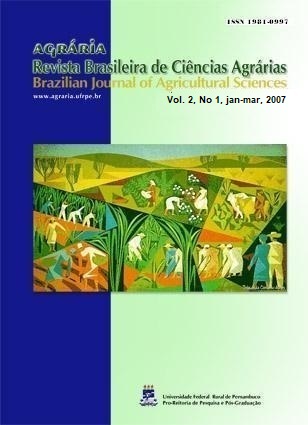Alteração da cor aparente de madeiras submetidas ao ataque de fungos apodrecedores
DOI:
https://doi.org/10.5039/agraria.v2i1a29Palavras-chave:
madeira de eucalyptus, resistência natural, massa específica básica, colorimetriaResumo
Propõe-se, com este estudo avaliar a alteração da cor das madeiras de Eucalyptus camaldulensis Dehnh. e Eucalyptus pilularis Smith, após serem submetidas ao ataque dos fungos apodrecedores Ganoderma applanatum e Gloeophyllum striatum, em comparação com suas cores naturais determinadas anteriormente ao ataque desses fungos, verificar a existência de um padrão de cor para fungos de podridão-branca e parda nas espécies E. pilularis e E. camaldulensis e analisar a relação entre a perda de massa e a massa específica básica das espécies estudadas. De cada espécie foram retiradas amostras para determinação da massa específica básica e para a determinação da cor, antes e após o ataque dos fungos. Após o ataque, o padrão de cor oliva amarelado das madeiras estudadas não se alterou, apesar das espécies apresentarem coloração mais escura. Para o E. camaldulensis não se observou uma relação entre a variação da massa específica básica e a perda de massa ao longo da árvore. Constatou-se para o E. pilularis, um aumento na perda de massa no sentido base–topo, independentemente da relação entre a variação da massa específica básica e a perda de massa ao longo da árvore. Ambas as espécies foram classificadas como altamente resistentes.
Downloads
Downloads
Publicado
Como Citar
Edição
Seção
Licença

Este trabalho está licenciado sob uma licença Creative Commons Attribution 4.0 International License.


